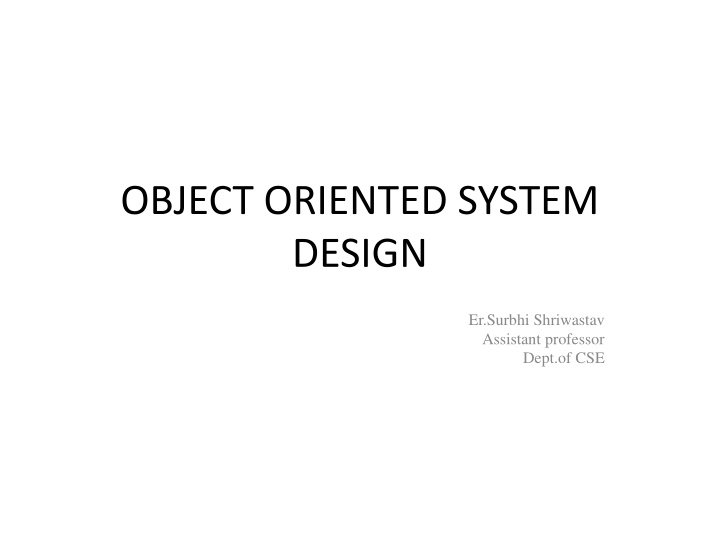
Object-Oriented System Design Principles
Explore the fundamentals of Object-Oriented Programming (OOP), learn about classes and objects in C++, and discover the advantages of OOP over procedural programming. Dive into creating classes, objects, and accessing attributes, all illustrated with clear examples and explanations. Enhance your knowledge of OOP concepts for effective system design.
Uploaded on | 0 Views
Download Presentation

Please find below an Image/Link to download the presentation.
The content on the website is provided AS IS for your information and personal use only. It may not be sold, licensed, or shared on other websites without obtaining consent from the author. If you encounter any issues during the download, it is possible that the publisher has removed the file from their server.
You are allowed to download the files provided on this website for personal or commercial use, subject to the condition that they are used lawfully. All files are the property of their respective owners.
The content on the website is provided AS IS for your information and personal use only. It may not be sold, licensed, or shared on other websites without obtaining consent from the author.
E N D
Presentation Transcript
OBJECT ORIENTED SYSTEM DESIGN Er.Surbhi Shriwastav Assistant professor Dept.of CSE
What is OOP? OOP stands for Object-Oriented Programming. Procedural programming is about writing procedures or functions operations on the data, while object-oriented programming is about creating objects that contain both data and functions that perform
OOP has several advantages over procedural programming OOP is faster and easier to execute OOP provides a clear structure for the programs OOP helps to keep the C++ code DRY "Don't Repeat Yourself", and makes the code easier to maintain, modify and debug OOP makes it possible to create full reusable applications with less code and shorter development time.
What are Classes and Objects? CAR VOLVO AUDI TOYOTA
Classes/Objects C++ is an object-oriented programming language. Everything in C++ is associated with classes and objects, along with its attributes and methods. For example: in real life, a car is an object. The car has attributes, such as weight and color, and methods, such as drive and brake. Attributes and methods are basically variables and functions that belongs to the class. These are often referred to as "class members".
Create a Class Create a class called "MyClass": class MyClass { public: int myNum; string myString; // Attribute (string variable) }; // The class // Access specifier // Attribute (int variable)
Create an Object class MyClass { public: int myNum; string myString; // Attribute (string variable) }; Create an object called "myObj" and access the attributes: // The class // Access specifier // Attribute (int variable) int main() { MyClass myObj; // Create an object of MyClass // Access attributes and set values myObj.myNum = 15; myObj.myString = "Some text"; // Print attribute values cout << myObj.myNum << "\n"; cout << myObj.myString; return 0; }
Multiple Objects You can create multiple objects of one class: // Create a Car class with some attributes class Car { public: string brand; string model; int year; }; int main() { // Create an object of Car Car carObj1; carObj1.brand = "BMW"; carObj1.model = "X5"; carObj1.year = 1999; // Create another object of Car Car carObj2; carObj2.brand = "Ford"; carObj2.model = "Mustang"; carObj2.year = 1969; // Print attribute values cout << carObj1.brand << " " << carObj1.model << " " << carObj1.year << "\n"; cout << carObj2.brand << " " << carObj2.model << " " << carObj2.year << "\n"; return 0; }
Class Methods Methods are functions that belongs to the class. There are two ways to define functions that belongs to a class: Inside class definition Outside class definition
class MyClass { public: void myMethod() { // Method/function defined inside the class cout << "Hello World!"; } }; // The class // Access specifier int main() { MyClass myObj; myObj.myMethod(); // Call the method return 0; } // Create an object of MyClass






















